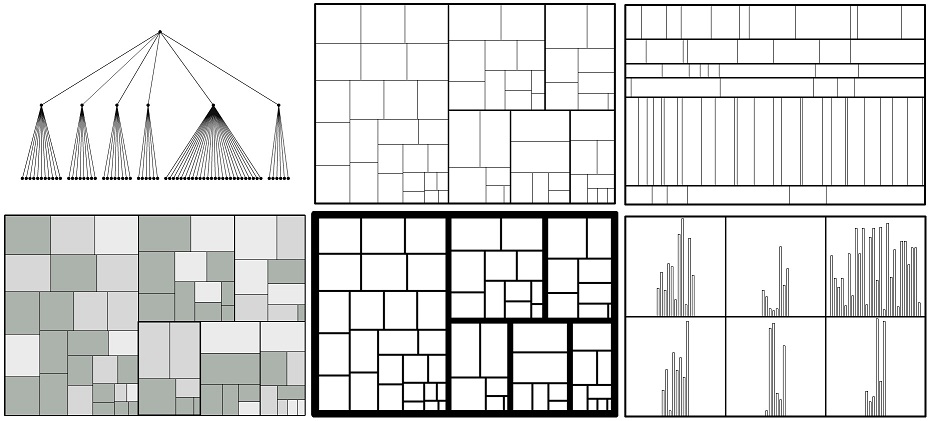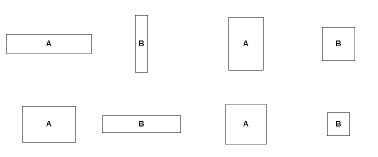Teaching:TUW - UE InfoVis WS 2010/11 - Gruppe 03 - Aufgabe 2
Perceptual Guidelines for Creating Rectangular Treemaps
Abstract
The following Article is a summary of the work of Nicholas Kong, Jeffrey Heer, and Maneesh Agrawala [Nicholas Kong et al., 2010]. It discusses the advantages and disadvantages of treemaps as visualization tool.
1. Treemaps - Basics

Treemaps are used for space efficient visualizing large, hierarchical datasets. Therefore every node in a tree is represented by a rectangular area in the treemap, where the size is proportional to the value of the node. The hierarchy of the tree is encoded by recursively subdividing the parent areas in the treemap. Following parameters have to be configured carefully to design perceptually effective treemaps:
- aspect ratio of rectangles (affected by the chosen layout algorithm)
- luminance of rectangles (used to encode additional variables)
- thickness of borders (used to encode hierarchy)
The problem with using treemaps is the use of area for encoding data. Studies have shown that people generally underestimate area, which leads to more inaccurate decoding than with other visualization types, like bar charts. Bar charts, on the other hand, are less space-efficient, not useful for visualization of hierarchies with more than two levels, and more difficult to read at higher data densities. The underlying work gives a design guideline, based on three experiments, when to use treemaps and when to use other visual encodings and how to choose the parameters.
2. Pilot Study – True Percentage and Luminance
The authors first conducted a pilot study on true percentage and luminance to prove prior studies. The term true percentage means the physical difference of two values measured in percent. Following results could be gained:
- true percentage has a strong effect on judgment accuracy
- More accurate judgment at either small (5%) or high (95%) percentage, more accurate judgment at multiples of 5 (due to our behavior to specify numbers at factors of 5)
- luminance has no significant effects on judgment accuracy
- Because area and luminance are separable perceptual dimensions, luminance does not interfere with area judgment.
3. Experiment #1: The Effects of Aspect Ratio
The first experiment presented by Kong et al. [Nicholas Kong et al., 2010] assessed both the effects of aspect ratio on rectangular area judgments and the effects of aspect ratio on proportional judgments.
They further hypothesized three things:
- extreme aspect ratios hamper judgment accuracy
- squares would hinder judgment accuracy
- different primary orientation would increase the error rate
3.1. Method

They conducted a series of controlled experiments to explore their hypothesis:
Kong, Heer & Agrawala asked subjects to compare rectangular areas with varying size and aspect ratios. For this purpose they showed subjects images (Fig. 2) containing two rectangles (A or B) and asked them to identify which is the smaller one. Further they had to guess the percentage the smaller was of the larger rectangle.
3.2. Results
They collected 2,600 responses to analyze:
- No effects of orientation on judgment accuracy were found.
- They did find a significant interaction effect between orientation and aspect ratio.
- Average judgment accuracy improves when comparing rectangles with varied aspect ratios.
- The highest error occurred comparing two extreme aspect ratios or squares.
3.3. Results
Their results support the general intuition against using treemaps using rectangles with extreme aspect ratios.
"It instead seems that squarified algorithms are effective in part because (a) they avoid extreme aspect ratios and (b) in most cases they are unable to perfectly achieve their “squarification” objective, instead producing a distribution of aspect ratios." [Nicholas Kong et al., 2010]
TODO
... ... ... ...
6. References
[Nicholas Kong et al., 2010] Nicholas Kong, Jeffrey Heer, Maneesh Agrawala. Perceptual Guidelines for Creating Rectangular Treemaps. IEEE Transactions on Visualization and computer Graphics, 16(6):990-998, November/December 2010.